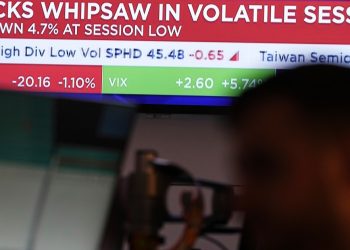President Trump’s imposition of high tariffs on friend and foe alike has stunned the world and stumped economists. There is no economic rationale, experts say, for believing these tariffs will usher in a new era of American prosperity.
But there is order amid the chaos, or at least a strategy behind it. Mr. Trump’s tariffs aren’t really about tariffs. They are the opening gambit in a more ambitious plan to smash the world’s economic and geopolitical order and replace it with something intended to better serve American interests.
This plan is often referred to as the Mar-a-Lago Accord. Apparently devised by Mr. Trump and two of his top economic advisers, Treasury Secretary Scott Bessent and Stephen Miran, the chairman of the White House Council of Economic Advisers, it seeks to improve the United States’ global trading position by using tariffs and other strong-arm tactics to force the world to take a radical step: weakening the dollar via currency agreements. This devaluation, the theory goes, would make U.S. exports more competitive, put economic pressure on China and increase manufacturing in the United States.
There is genuine economic, social and political discontent driving this plan. Given the demise of U.S. manufacturing and the post-Cold War development of a technologically interconnected world shaped by new geopolitical rivalries, some sort of reset of the economic order probably makes sense for the United States.
But the slash-and-burn approach of the Mar-a-Lago Accord isn’t the answer. For one thing, it is hard to find an economist outside of Mr. Trump’s inner circle who thinks it is a good idea. But even if, despite all the chaos it will unleash, the United States eventually prospers as a result, we will have traded away the core economic and political values that make America truly great.
This is not the first time that concerns about an overly strong U.S. dollar have prompted a major policy response. In more than just its name, the Mar-a-Lago Accord echoes the Plaza Accord of 1985, an agreement among the G5 nations, signed at the Plaza Hotel in New York City, to devalue the dollar through a series of coordinated moves.
The Plaza Accord was a response to two seismic developments. First, with the collapse in the 1970s of the postwar international monetary system known as Bretton Woods — which had pegged the value of the dollar to gold at a fixed price — the dollar was set free on an unregulated currency market. Second, in the 1980s, after Paul Volcker, the Federal Reserve Board chairman, implemented high interest rates to fight inflation, the dollar became irresistible to foreign governments and private investors alike. Foreign capital poured into the United States.
The result was a strong dollar — too strong. American-made goods became some of the most expensive in the world, creating a large trade deficit and accelerating the flight of manufacturing from the United States. It is no coincidence that Mr. Trump’s early public complaints about other countries “ripping us off” date from this time.
The Plaza Accord reduced trade deficits, as it was intended to do, but the basic trends continued. In the decades since, the dollar has remained the world’s reserve currency. Today, gold and oil are demarcated in dollars, facilitating global trade; foreign nations hold U.S. Treasury bonds in their official accounts as a store of value, a hedge against uncertainty and a way to stabilize their currencies.
To many, the strong dollar grants the United States “exorbitant privilege,” as a French finance minister once griped, cementing U.S. diplomatic, military and cultural dominance. To lose this status would be a doom scenario, potentially leading the United States to default on its debt and plunging the country into economic catastrophe and social collapse.
What the Trump administration is arguing, in effect, is that the doom scenario is already here: We have an America where manufacturing has declined, economic inequality has spread and a nation overburdened with debt pays for the military protection of its allies.
In response, the Mar-a-Lago Accord tries to reverse history. As sketched out in “A User’s Guide to Restructuring the Global Trading System,” a paper published by Mr. Miran in November, the first step is disruption: tariffs that shatter the existing economic order and drive countries to the negotiating table. Once at the negotiating table, countries will be asked to take steps via currency agreements to lower the value of the dollar.
Should allies refuse to bend to the tariffs and decide instead to retaliate with levies of their own, they may find the United States withdrawing from defense agreements such as NATO. “Countries that want to be inside the defense umbrella,” Mr. Miran writes, “must also be inside the fair trade umbrella.” If unregenerate allies were to significantly increase their military spending in response, the Trump administration would chalk that up as a win.
Unlike in 1985, large numbers of U.S. dollars today are held by China. Lowering their value would amount to financial warfare with China, which the plan endorses. Mr. Miran argues that it is important to “intertwine trade policy with security policy.” Much as the Cold War arms race with the Soviet Union squeezed the Communist system to the point of collapse, this strategy seeks to cut off China from the world economy through punishing tariffs, or a user fee on reserves, which would eventually force transformative change.
If everything goes as planned, U.S. exports would be more competitive globally, China would be weakened and more of our allies would be sharing the burdens of military spending. The upshot would be more manufacturing in the United States and a reinvigorated American heartland.
Will it work? Few economists think so. Many prophesize disaster, pointing out the enormous risks of economic turbulence. Even Mr. Miran admits the possibility. It is critical to “start small and take small steps,” he writes — an approach that seems unlikely in an administration that prizes bold action.
There is an even bigger problem with the plan, though, than its slim prospect of success. Perhaps the United States could manage in a world that does not run on the dollar. But the dollar is the world’s reserve currency because it is considered the most reliable place to store assets and to invest — a haven from expropriation, political retribution and economic unpredictability. Foreign states and individuals alike invest in the United States because they believe our political system is stable, our legal system is fair and private property is valued.
The dollar became strong after World War II when the United States committed to supporting a web of economic and military alliances intended to stave off conflict and ensure peace through trade. The dollar remained strong because, as other nations entering the global trading system fell prey to corruption, cronyism and civil unrest, the U.S. economic and political system stood out as a beacon of security, innovation and enterprise.
The most valuable asset of the United States is not the dollar but our trustworthiness — our integrity and our values. If the world envisioned by the Mar-a-Lago Accords comes to pass, it will be a sign that not only our currency but our nation has been devalued.
Jennifer Burns (@profburns) is an associate professor of history at Stanford, a research fellow at the Hoover Institution and the author of the “Milton Friedman: The Last Conservative” and “Goddess of the Market: Ayn Rand and the American Right.”
The Times is committed to publishing a diversity of letters to the editor. We’d like to hear what you think about this or any of our articles. Here are some tips. And here’s our email: letters@nytimes.com.
Follow the New York Times Opinion section on Facebook, Instagram, TikTok, Bluesky, WhatsApp and Threads.
#Opinion #Method #Trumps #Tariff #Madness






















